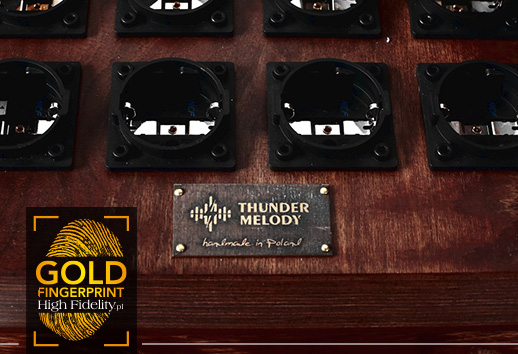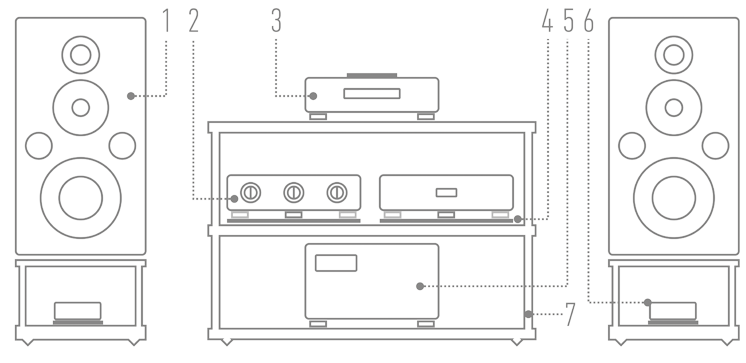|
POWER CONDITIONER AC Thunder Melody
Producent: INNOVACOM Sp. z o.o. |

|
REVIEW
text WOJCIECH PACUŁA |

|
No 224 January 1, 2023 |

The company from Henryków specializes in reducing RF and EM noise. For this purpose, it uses proprietary developments, offering anti-vibration products, power supplies and connection cables. As Mr. Rafał Hładziak said, these products are the result of two years of work in the laboratory.:
The Thunder Melody offer is divided into three series: Silver, Gold and Black. In the case of the latter, as the designers say, there is no upper price limit, because multiple techniques can be used. Almost any of the company's products can be purchased first in the Silver version and over time can be upgraded to the Black version. Only some of them do not offer such a possibility due to construction limitations, about which the customer is informed in advance. The GRAAL, the AC supply voltage conditioner, tested this time, belongs to the last, top series. What's more, it is a maximally extended version - more sockets do not fit in it. This is important because each socket is in fact a separate conditioner. Typically, the power taken from the wall socket is conditioned (cleaned from noise and interference) and only then it is divided into separate, no longer separated outputs. Sometimes, in better products, the low-level (for CD etc.) and high-level (amplifiers) outputs are additionally conditioned separately. Hence the high price of the unit we are testing - PLN 108,000 for the conditioner is an astronomical amount. However, high-end costs money, and extreme high-end costs correspondingly more. And this is not a price just thrown out there, but the price for an already sold unit, with another one also ordered by the customer. | A few simple words… KONRAD RAŚ 
GRAAL BLACK IN THE VERSION that we provided for the test has 12 outlets located on the top, as well as an additional output/input for ground conditioning. This is our top version. 11 outlets conditioned several times more effectively than the conditioned outlets in the Silver version, which was the subject of the previous review. One port is unconditioned ("straight"), so that an external filter, e.g. Thunder Melody Vacuum Infinitum, can be connected to it. This is also the purpose of the target configuration. The tested configuration is also equipped with Monument technology, although this version of the chassis makes it impossible to place another device on it. These technologies are used by the conditioner itself. The mass conditioning functionality is also combined with this technology. The device can be used as a ground conditioner, but it can also be connected to an external central ground conditioning of the Monument Ground Hub or to a dedicated PE ground. If we do not have external conditioning or dedicated grounding, then we put the attached jumper on the ground ports and in this way we use the grounding from the audio line (not recommended). It is recommended to connect the ground output to any line other than the audio line. If we have no other option, a jumper is still a better option than no connection. 
As I mentioned, the Grail Black model is a much broader approach to taking care of the lowest possible noise floor, already at the central power supply stage, than in the budget Silver model. Also, conditioning modules dedicated to each conditioned port allow them to operate independently and prevent transmission of interference between ports. This, in the analogy of computer networks, is like comparing a switch to a hub - a shared version versus a common interference domain. "Unfortunately" all these options, techniques and approaches to the issue of power supply result in, apart from the effects of an audio nature, also serious costs. For the test configuration, they amount to PLN 108,000. According to tradition, we deliver the top Thunder Melody products personally to the customer, we implement and and launch them together. Versions with fewer ports/conditioning/non-conditioning/arrangement of ports on the rear panel, while maintaining the Black version, cost adequately less. The tested version is the most advanced one that makes sense and that you can get as a single device. For systems with monoblocks, a configuration of paired conditioners (made identically in parallel) with a smaller number of ports and a common conditioner connecting them is more suitable. There are as many variants as there are potential owners, everything is individually customized and priced. ● GRAAL BLACK BY THUNDER MELODY is a passive AC power conditioner. Passive, i.e. there are no elements in the path, and the effect of reducing noise in the supply voltage is achieved by placing the cables in the vicinity of appropriate materials. Graal also serves as a voltage divider. In the tested version, there are eleven filtered sockets and one unfiltered one, intended for connecting an additional, external filter. The product is very large and incredibly heavy - it weighs over 35 kg. It can of course be smaller and lighter, and it all depends on how many sockets we need. Its housing is made of "panzer" plywood and finished with oil. The sockets were purchased from Furutech and these are its top NCF models, here with rhodium-plated contacts. Also the IEC socket is from the same series. There are two WBT sockets on the side - good and even better ones :) This is part of the mass conditioning system. The set includes a jumper that connects the sockets, if we do not use an external artificial ground. If we use it, we connect it to the better of the two sockets. The tested unit did not feature any feet, but Graal Black can be equipped with them on request. It can also be placed on the Monument anti-vibration platform. Together with filters and artificial mass, we can spend up to PLN 200,000 on this one element of the audio system. 
▌ SOUND ⸜ HOW WE LISTENED The GRAAL BLACK conditioner was tested in the HIGH FIDELITY reference system. It was powered by a 2.5-meter Acrolink Mexcel 7N-PC9500 AC cable. The Acrolink was connected to a Furutech NCF wall socket with a separate power line with its own fuse. |
The conditioner was compared to the ACOUSTIC REVIVE RPT-4EU ABSOLUTE power strip. It was placed on the Acoustic Revive RST-38H anti-vibration platform. I connected three elements from my reference system to it: the Ayon Audio CD-35 HF Edition SACD player (cable: Siltech Triple Crown), the Ayon Audio Spheris III preamplifier and the Soulution 710 power amplifier (both with Acoustic Revive Absolute Power cables). The comparison was conducted as A/B and A/B listening sessions with A and B known. The auditioned fragments of tracks were 1 to 2 minutes long. Since the system takes a while to go into standby mode, the comparison was not immediate - the interruptions were about 60 seconds long. ⸜ Recordings used for the test | a selection
⸜ THE OSCAR PETERSON TRIO, We Get Request, Verve/Lasting Impression Music LIM K2HD 032, K2HD Mastering, „24 Gold Direct-from-Master Edition UDM”, Master CD-R (1964/2009). THE BEST PRODUCTS FOR IMPROVING THE QUALITY OF THE POWER SUPPLY DON'T CAUSE THE "WOW!" EFFECT. In the sense that changing one good product to another does not make us open our wallet right away. Of course, I am talking about the investment portfolio – these are not cheap things. They do something else - they attract our attention. And once they pull s in, they don't want to let us go. And that's something completely different. That's how I feel about Thunder Melody products. OSCAR PETERSON'S TRIO from We Get Requests, which I had listened to so many times before, was interesting again. I started the listening session in an unusual way, because not with the greatest hits, but with two atmospheric tracks: People and Have You Met Miss Jones?. It allowed me to free myself from the scripts that grew on me when comparing other products using this album. And the first thing I heard was a lot less "noise" behind the instruments. The sound with the Graal Black conditioner was noticeably quieter as a whole. So I could turn up the volume knob by 1 or even 2 dB to get a subjective sound of the same volume level. As a result, the dynamics of the signal increased significantly. Previously perfect, without a trace of problems, now it was just higher. As if a slight internal tension was removed from the presentation I had. Something as if the Acoustic Revive strip focused on making everything perfect, and the conditioner did it effortlessly. Nothing changed in the sound, in both cases it was a similar way of thinking about the presentation, but the effect was different. Peterson's album was recorded in 1962 at RCA Studios in New York and has a sound signature characteristic of that period. The sound is resolving and selective, but the reverberations are slightly muffled. You can hear that they tried to gather the instruments up close and that the acoustics of the studio is not too big. Takehiro Honda's This is Honda is completely different. Released in 1972 by the Japanese Trio label, it was recorded in Tokyo's Lino Hall by the outstanding Okihiko Sugano (more about his life and work → HERE). And it sounds completely different. 
This is also a piano trio, and it was also recorded in a classic arrangement, with a piano in the middle, percussion on one side and a double bass on the other. Except that the last two instruments are in the opposite configuration than on Peterson's album. More important, however, is that there is much more natural reverberation here - Sugano did not use reverberation devices. The Thunder Melody conditioner did something opposite than before, i.e. it brought the instruments slightly closer to me and showed them in a larger volume. For a moment I couldn't figure it out because I didn't know what was going on. However, when I heard the "singing" of the double bassist Yoshio Suzuki, who - like Ray Brown from We Get Requests, sings along when playing, I knew what it was all about. And the thing about resolution. Now it was higher, so the musician's grunts, his inhalations, etc. were less of a "disturbance" and more of a "color". While I'm used to Brown and his humming, Suzuki does it harder, which sometimes makes me have a problem with it. And with the Grail in the Black version it was a natural extension of the music to the side. As if a different dimension had been added to it./p> With the Honda album, I didn't have to turn up the volume to make it sound similar to what it was before. But I could do it with the next album, Silk&Soul by NINA SIMONE. Perhaps because the sound was recorded on it in a similar manner as Peterson's trio, in a slightly muffled way, as if the instruments were placed next to a wall made of absorbing material. And the Thunder Melody extracted more information from the signal, so I could listen to the album louder, simply getting more "sound in sound". It was a richer playback of the album. In terms of tonal balance, the Graal Black is very similar to what the Acoustic Revive strip offers. That's good, I think it's the right direction. Many conditioners and power strips slim down the sound, brighten it or sharpen it, sometimes they do it all at once. The tested conditioner is completely different. It darkens the sound, if anything, but because it eliminates all those "rustling" distortions, sometimes presented along the sound, sometimes behind it, but always irritating. Acoustic Revive does the same. The Polish product, however, treats instruments in a stereoscopic space differently. The strip strongly emphasizes the elements on the axis, giving them a large, close image. In turn, what is far behind - pushes a bit further away. Thunder Melody tones down these extremes a bit. I don't know what's right and what's less right, because both presentations are fascinating. But the Polish product in this respect will appeal more to people who do not like close sound, but would still like it to be resolving, tangible and selective. That's what the Graal is like. As it turns out, it shows sounds in a perfectly balanced way, separated but also combined. At the same time, it has a tendency to show larger plans. At least that's how we perceive it. When Enya in Fairytale from the The Celts is placed far back by the sound engineer, and the backing vocals slightly to the sides, but even a bit closer, then with the conditioner we get a smooth whole, with the vocals of the artist (this recording was made by multiple recordings of successive tracks with Enya's voice) spread out in a semicircle. However, there is one more thing I would like to point out. Graal Black draws our attention to the midrange. Not that it hides its extremes, that's not the point. Both high and low notes are perfectly readable and controlled. When the above-mentioned track ends, we get a very strong and low impulse - and the Polish conditioner showed it perfectly. Just like the very low bass from the AQUAVOICE’s Nocturn. This is an exceptionally good feature of it. From my power supply system, which consists of the Acoustic Revive strip, passive filter and anti-vibration platform of the same company, as well as anti-vibration clamps from Furutech, the tested conditioner differs in three elements: clearing the sound from the "background", which turns out to be distortion, and the scale and palpability of the sound. The first of these elements is obviously better in the Polish product. it is thus the best of all that I have heard at home so far. The second and third are just different. 
The scale in both cases was similar. The Graal Black, however, places it further away from the listening position, so we get a large space and the size of the instruments, but placed behind the line connecting the speakers. My system scales everything differently. It creates tangible sources of sound, almost at my fingertips, thanks to which the "weight" of the presentation is located closer to the listening position. ▌ Summary IN TERMS OF TONALITY GRAAL BLACK IS one of the most pleasant products among power devices I've heard. We get a very wide frequency response with it, but our attention is focused on the dense, almost warm midrange. Spatially, it is also a perfect creation, with the foreground moved away from us and the panorama leading far into the stage. When it comes to dynamics, it's just a firecracker, so to speak. Unlike usual, we are not "harassed" with the sound, because it is real dynamics, not an emphasized attack. The sound develops in front of us slowly, but with precision and rhythm that we fight for in audio. Thanks to the lower noise, we can turn up the volume knob higher than with other best products of this type, and the sound will not only be louder, but more "here and now", more natural in its dynamics. It is simply a top product. A ˻ GOLD Fingerprint ˺ from us, our most important distinction. ■ |
|
Reference system 2022 |
|
 1) Loudspeakers: HARBETH M40.1 |REVIEW| 2) Line preamplifier: AYON AUDIO Spheris III Linestage |REVIEW| 3) Super Audio CD Player: AYON AUDIO CD-35 HF Edition No. 01/50 |REVIEW| 4) Stands (loudspeakers): ACOUSTIC REVIVE (custom) |ABOUT| 5) Power amplifier: SOULUTION 710 6) Loudspeaker filter: SPEC REAL-SOUND PROCESSOR RSP-AZ9EX (prototype) |REVIEW| 7) Hi-Fi rack: FINITE ELEMENTE Pagode Edition |ABOUT| |
|

|
Cables Analog interconnect SACD Player - Line preamplifier: SILTECH Triple Crown (1 m) |ABOUT|Analog interconnect Line preamplifier - Power amplifier: ACOUSTIC REVIVE RCA-1.0 Absolute-FM (1 m) |REVIEW| Speaker cable: SILTECH Triple Crown (2.5 m) |ABOUT| |

|
AC Power Power cable | Mains Power Distribution Block - SACD Player: SILTECH Triple CrownPower (2 m) |ARTICLE| Power cable | Mains Power Distribution Block - Line preamplifier - ACOUSTIC REVIVE Power Reference Triple-C (2 m) |REVIEW| Power cable | Mains Power Distribution Block - Power amplifier - ACROLINK Mexcel 7N-PC9500 |ARTICLE| Power cable | Power Receptacle - Mains Power Distribution Block: ACROLINK Mexcel 7N-PC9500 (2 m) |ARTICLE| Power Receptacle: Acoustic Revive RTP-4eu ULTIMATE |REVIEW| Anti-vibration platform under Acoustic Revive RTP-4eu ULTIMATE: Asura QUALITY RECOVERY SYSTEM Level 1 |REVIEW| Power Supply Conditioner: Acoustic Revive RPC-1 |REVIEW| Power Supply Conditioner: Acoustic Revive RAS-14 Triple-C |REVIEW| Passive filter EMI/RFI: VERICTUM Block |REVIEW| |

|
Anti-vibration Speaker stands: ACOUSTIC REVIVE (custom)Hi-Fi rack: FINITE ELEMENTE Pagode Edition |ABOUT| Anti-vibration platforms: ACOUSTIC REVIVE RAF-48H |ARTICLE| Isolators: |

|
Analogue Phono preamplifier: Phono cartridges:
Clamp: PATHE WINGS Titanium PW-Ti 770 | Limited Edition Record mats:
|

|
Headphones Headphone amplifier: AYON AUDIO HA-3 |REVIEW|Headphones: Headphone Cables: Forza AudioWorks NOIR HYBRID HPC |
main page | archive | contact | kts
© 2009 HighFidelity, design by PikselStudio,
projektowanie stron www: Indecity







 HUNDER MELODY IS ONE of the most interesting audio companies I've come across in recent years. I'm glad that it's a Polish company, but the country of origin is just a nice addition here, and the products themselves could be made in any audiophile-developed country and would be a phenomenon there.
HUNDER MELODY IS ONE of the most interesting audio companies I've come across in recent years. I'm glad that it's a Polish company, but the country of origin is just a nice addition here, and the products themselves could be made in any audiophile-developed country and would be a phenomenon there.
